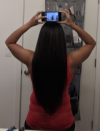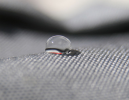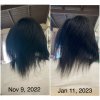First, your observation about the porosity change on your hair is 100% correct! Secondly, bravo for your accurate observation and for you intense analysis!
Here comes my unpopular opinion! (this is not a criticism of you
@keranikki ! I am stealing your post to use it as a teaching moment for all of us. )
On this point, regarding high porosity, I am very clear and knowledgable.
There is no such thing as LOW porosity! I am not splitting hairs. In the scientific world of hair, hair is either normal (undamaged) porosity or it is HIGH (damaged) porosity. There is no such thing as LOW porosity. There is no such things as MEDIUM porosity. How we name call something is so important. I make this differentiation because the information in scientific papers on hair, addresses porosity all the time. Hair is either normal porosity or high porosity.
This nomenclature may change in the future. For now, it has not.
So many people in the natural hair community say low and medium porosity. This terms are not used in the scientific literature and I mention them because their use is confusing people in the natural community.
It's a detail, but the scientific papers on hair can be more confusing if this distinction is not made. Lots of us read scientific papers on hair to get a more in-depth understanding and to substantiate and investigate things for ourselves. Thus, it is important to get off on the right foot.
The older the hair becomes, or, the farther away from the root, the hair becomes more and more and more porous. The hair on the end or tip of the hair strand is more damaged, more porous than the hair at the root.
The hair at the end or the hair at the tip of the strand is usually a higher porosity than the new hair at the root. That is because of weathering. Weathering happens over time. Weathering ages the hair.
This weathering is normal and inevitable for all hair.
- Brushing or combing or detangling hair weathers hair.
- Washing and conditioning hair weathers hair.
- The sunshine weathers hair.
Now, what do we do about it? We have to protect and baby our ends. It is impossible to completely stop weathering. Just like we age, our hair also ages! Therefore, over time, the hair will on the ends will become more porous, or be a higher porosity than the hair at the root. Some possibilities:
- As you did, look at your shampoo products. The type of cleansers inside them determine how harsh the shampoo might be. Look for shampoos with less harsh surfactants.
- Lessen the amount of times you use shampoo each month. Wash with less harsh shampoos.
- Replace the oil layer on the hair, as you are doing, by continuing to use and add Shea butter in your hair routine and to your ends.
"Living" is what is altering the porosity of your hair as it is growing out! Exposing the hair to the sun alters porosity. Washing the hair alters the porosity. Styling the hair alters the porosity. Sleeping on the hair alters the porosity. Using heat tools alters the porosity. Over time, the hair porosity, towards the ends is altered.
The actions you have taken are perfect. Using your water and clove concoction and your Shea butter concoction on your hair ends will better help you to preserve your ends with protection and care.
My question to you
@keranikki , could you please share and describe exactly which test you did and how you did it to determine that your hair was high porosity on the last 1/4 of the strand?
@keranikki
Thank you so much for bringing your situation and great analysis to this thread!







 so it forms a bead. The thicker or greasier or waxier the surface, the tighter the ball of water rolls up. The thicker the grease on the surface, the BIGGER the contact angle of the water bead, to the the surface.
so it forms a bead. The thicker or greasier or waxier the surface, the tighter the ball of water rolls up. The thicker the grease on the surface, the BIGGER the contact angle of the water bead, to the the surface.

 )
) I had a professional hair analysis done years ago and they told me the same thing.
I had a professional hair analysis done years ago and they told me the same thing.


